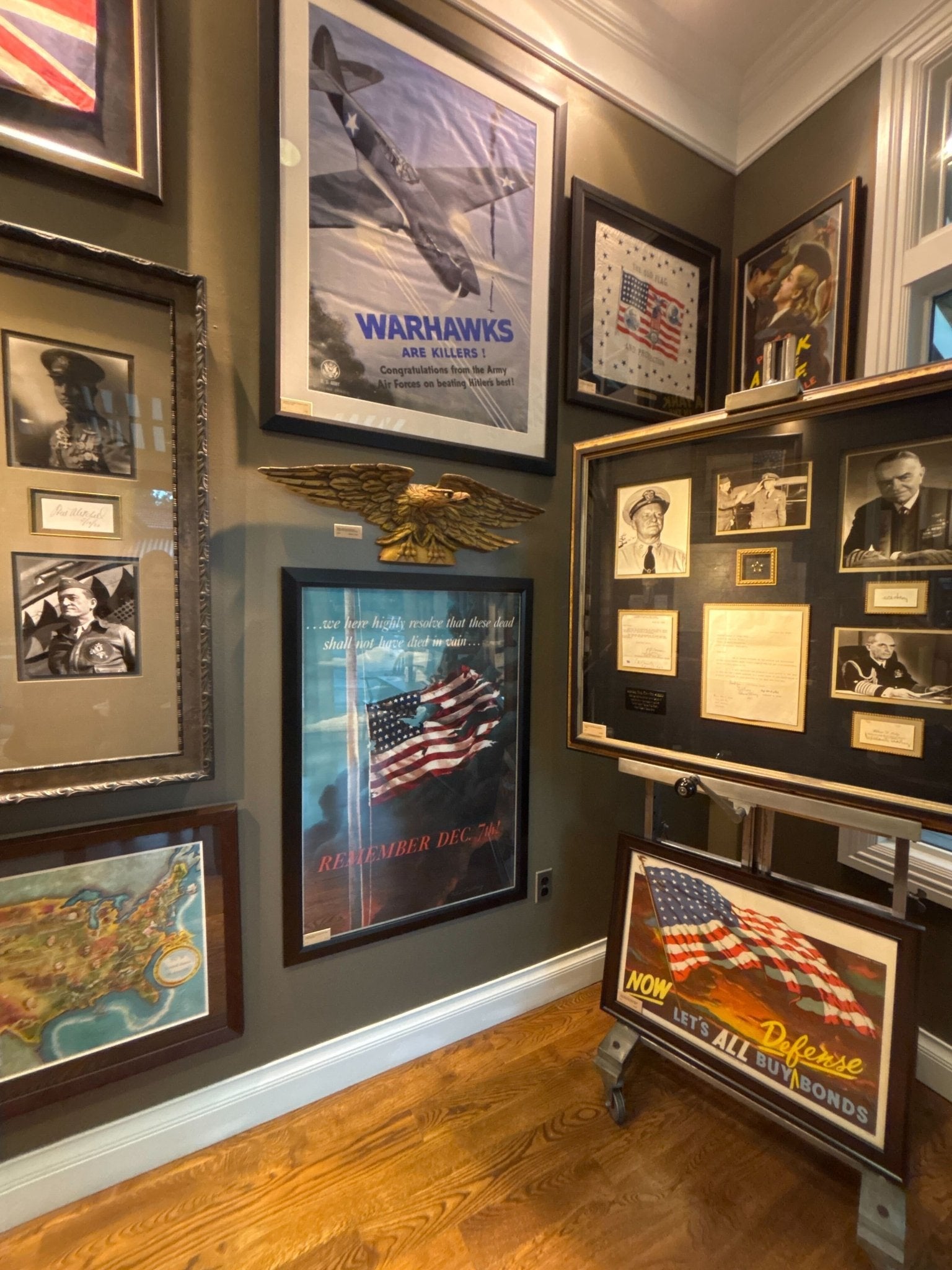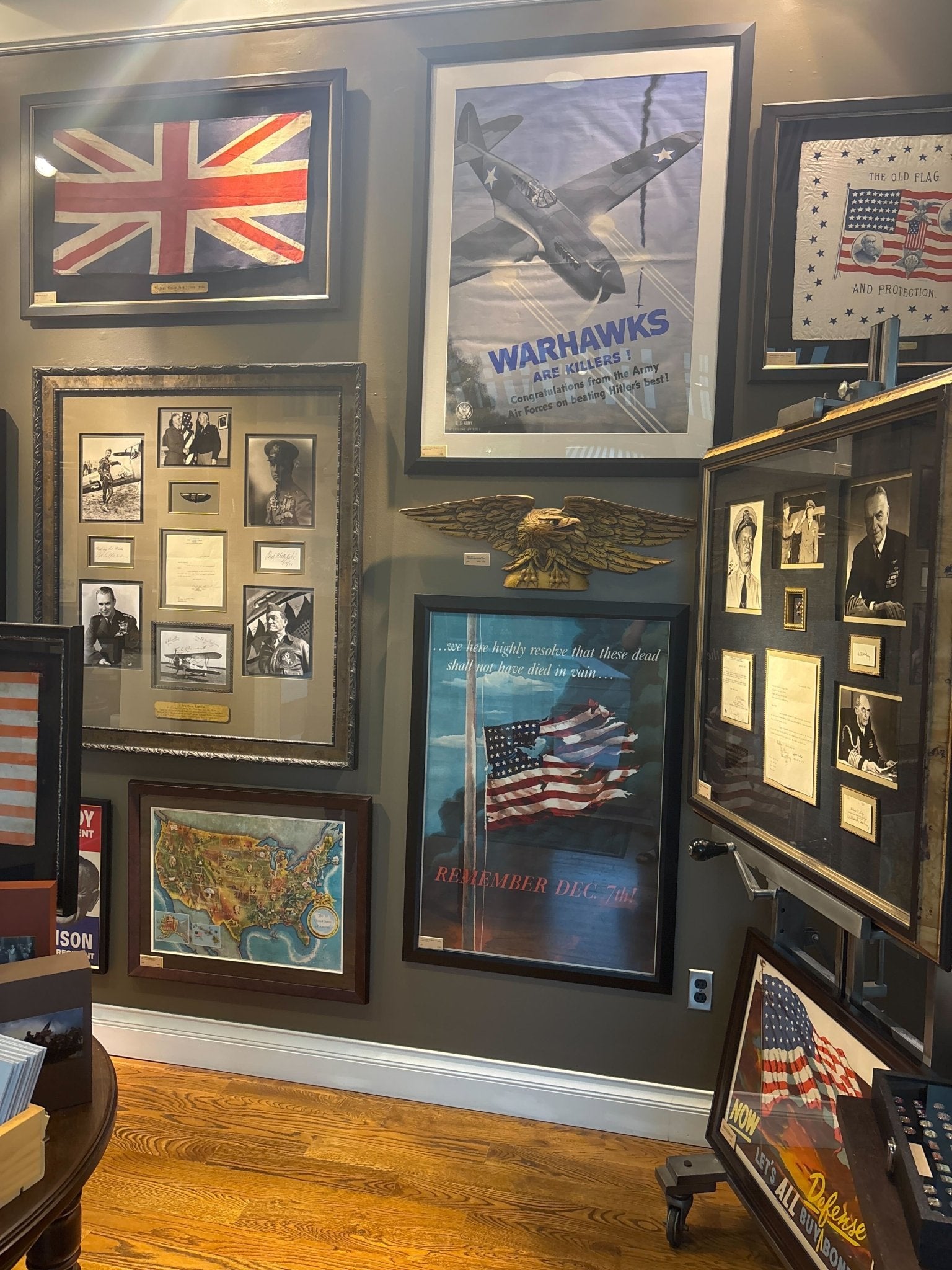



"Warhawks Are Killers!" Vintage WWII U.S. Army Air Force Poster, 1943
Presented is a vintage WWII U.S. Army Air Force poster of a P-40 Warhawk fighter plane. The poster was illustrated by Melbourne Brindle and published by the Recruiting Publicity Bureau in October of 1943. The poster depicts a Curtiss P-40 fighter flying through the sky with guns firing at full force. In the background, a doomed enemy aircraft plummets to earth with a trail of smoke marking his descent. The poster text reads “Warhawks are Killers”in blue block letters across the clouds at the bottom of the composition, with the text “Congratulations from the Army Air Force on beating Hitler’s best” just below in black block letters.
Built by the Curtiss-Wright Corporation, the P-40 Tomahawk was a single-seat, all-metal fighter and ground attack aircraft that first flew in 1938. An early prototype version of the P-40 was the first American fighter capable of speeds greater than 300 mph. From 1939 to 1944, over 13,730 P-40s were built, making it the third most-produced American fighter of the Second World War, after the P-51 and P-47.
Although it struggled in high altitudes, the P-40 was a very rugged aircraft and could tolerate harsh conditions in a wide variety of climates. Its strong structure enabled the P-40 to survive mid-air collisions and weapons fire that would take down most other Allied and Axis fighters of the time. The P-40 played a critical role with Allied air forces in three major theaters- North Africa, the Southwest Pacific, and China. The planes were famously flown by Claire Chennault and his Flying Tigers, helping to decimate the Japanese air force in China. The P-40 also had a significant role in the Middle East, Eastern Europe, and Italy, where it served as an air superiority fighter, bomber escort, and fighter-bomber.
Born in Australia, artist Melbourne Brindle immigrated with his family to San Francisco after the World War I Armistice in 1918. After a brief stint at local art schools, Brindle worked in a department store as a letterer, eventually progressing to the role of an advertising illustrator. Brindle joined an advertising agency in San Francisco, where the young artist completed over 20 illustrations for Fortune magazine and received two Art Directors Club Gold Medals for his work.
In 1938, Brindle moved to New York to start his own advertising and illustration business. He quickly built up a roster of commissions from major corporations including Ford Motor Company, General Motors, Chrysler, Packard, Douglas Aircraft, United Airlines, Allied Chemical, Gruen Watches, Seagrams, and many more. His ads appeared in Fortune, Esquire, Collier’s, and National Geographic, and his illustrations graced the covers of the Saturday Evening Post and Medical Times. During World War II, he created war bonds and recruitment posters.
Brindle’s life-long passion for antique automobiles led to his recognition as one of the finest car illustrators in the United States. He portrayed the Ford Thunderbird and the Buick Riviera in their first ever advertisements in 1955 and 1963, and updated the Goodyear Tire ads with a new car each year in the 1950s and 1960s. He researched and illustrated Twenty Silver Ghosts, a book of paintings of pre–World War I Rolls-Royces with text by Phil May, which was published in 1971.
For the US Post Office, Brindle designed a 1971 set of stamps on Historic Preservation, 1972 postal cards for the Tourism Year of the Americas, the 1975 "World Peace through Law" stamp, and a 1982 postcard depicting the Academy of Music in Philadelphia.
CONDITION:
Original color lithograph. The color is still very vibrant. Crease at centerfold and small creases throughout in the outer margins. Light surface toning to outer margins. Signed by the artist in the lithographic stone “Melbourne Brindle.” The U.S. Army logo is printed in white at the bottom left of the composition. "P-X-3-RPB-10-11-43-7500" and the Recruiting Publicity Bureau United States Army logo is printed in the bottom right margin. Unframed Dimensions: 42 1/2"H x 31"W.
Custom framed to conservation standards, with UV plexiglas, acid-free mats, and a custom-built black wooden frame.
Framed dimensions: 47 1/4"H x 36 3/4"W x 3/4"D.
Accompanied by our company's letter of authenticity.
Pickup currently unavailable at Colorado

"Warhawks Are Killers!" Vintage WWII U.S. Army Air Force Poster, 1943
Colorado
1 Lake Avenue
Colorado Springs CO 80906
United States
Choose options




Frequently Asked Questions
FAQs
Yes, all of our Antiques are certified authentic. Every antique comes with a signed Letter of Authenticity that details the item’s history, its current condition including any conservation, binding, or framing work, and the item’s provenance. The Letters of Authenticity are priced valuations by our authentication specialists, who assure that items are original and unconditionally guaranteed as genuine for life.
We pack and ship your items from our gallery in Colorado Springs. You may also choose to come pick up your order. Antique items are carefully packed and insured during shipping. The shipping price will be calculated at checkout.
We acquire from a variety of trusted sources all over the world, but mostly through auctions and private collections within the United States. All provenance information will be listed on the Letter of
Authenticity accompanying your purchase.

